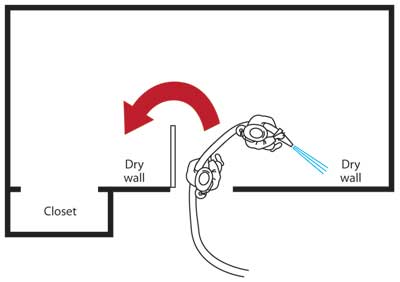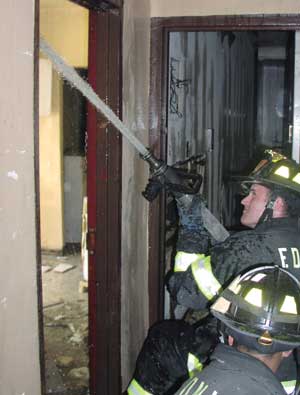BY RAY McCORMACK
When the engine company enters the attack space, it has a forward nozzle posture. Although we need to attack the whole compartment for a successful knockdown, most often we miss one area, the one that holds its fire the longest, the entrance wall or the “dry” wall. For complete extinguishment, we need to wet this dry wall because this is where we will typically find fire behind us within the fire room.
When we enter the fire room, the nozzle is out in front of the nozzle firefighter, and its movements cover areas forward and to the sides of his position. The doorway through which the team enters is not only the entrance wall but also the room’s dry wall. Once the nozzle team is fully in the fire compartment, this wall is now behind us and may still be burning. Any furniture, shelving, or other items lining it are usually still free burning and need further extinguishment. The nozzle used does not reduce the impact of the dry wall or fire behind you.
The fire room door’s swing often interferes with our ability to cover portions of the dry wall without assistance from another nozzle team member. Always investigate the space behind this door during search and extinguishment. Depending on how the nozzle firefighter enters the room, the space behind the door may be judged by feel and door movement. When the entrance door does not swing as much as you would like it to, consider what might be interfering with it. Don’t assume that the lack of a full swing means that there is nothing more to that side of the doorway; sometimes a closet wall or another room wall may be directly behind the door, allowing it to swing only perpendicular to its opening. Some firefighters like to use the door side for nozzle entry so that there is something to lean against and to help to determine the entry door’s swing distance. Doors can also hide and mask fire conditions. If there is no additional wall space behind the door and it aligns with a parallel wall, then you know that the dry wall will be on only one side of the doorway.
If the room you enter does not have a door, you still have to take care of fire on either side of the entryway, which is often the case with kitchen and gathering rooms. The entrance wall is the dry wall. This wall and your distance from it as you continue to move forward are two items to keep in mind as you attempt to put the fire out. Remember the direction from which you entered, and give that dry wall behind you a shot.
It is not uncommon to knock down the main body of fire (especially in a bedroom) and discover soon after that there is fire behind the nozzle team. This additional fire can range from very serious to a minor flareup. Many times, shelving and whatever is on it, dressers, chairs, or other common furniture along the dry wall will still be burning behind the nozzle team. Closets are another common element that can hold fire longer than any other item along the dry wall. This semienclosed space often conceals fire and is typically difficult to fully extinguish on the first sweep; its doors may only be partially burned through, and you must aim the nozzle lower to get below the closet header (Figure 1).
| Figure 1. Hitting the Dry Wall |
 |
| On entry, firefighters must get initial water on the accessible side of the dry wall as soon as possible. As they move farther into the room, they must investigate (arrow) what’s behind the door (e.g., shelving, furniture, closets) and get initial water on it too. |
No nozzle team wants to find fire behind its position, yet we often face such a dilemma. At a typical single well-involved room fire, without some dedicated nozzle movements or directional changes, this event will occur to some extent. To reduce the severity of this event, wet down the dry wall—water conservation is not an issue when gaining direct extinguishment. The nozzle team that understands extinguishment knows that it needs to apply water to cover the burning surfaces until knockdown is achieved.
Depending on your style of nozzle movement and the coverage area for which you are aiming, you may typically deal only with minor dry wall flareups. However, if the dry wall has a recessed area that is initially blocked from your efforts, this additional fire area presents a significant danger to the nozzle team. The best way to combat this common fire situation is to first be aware of it and then to take steps to reduce its impact.
Fully involved rooms typically vent a portion of the fire toward the nozzle team. Once fire is extending out of the room, extinguishment must also start outside the room. Given these parameters, as you start to hit the fire and move forward and enter the fire room, you must also move the nozzle at a dedicated angle to the dry wall or move your body slightly in that direction while performing your typical extinguishment pattern. Although we always want to cover as much of the room as possible in our initial attack sweep, it is not always possible. By employing either of these techniques, you have moved from early recognition to action. You should incorporate hitting the dry wall so fire cannot come back forcefully.
Some firefighters must be directed to hit this area as they move deeper into the fire room. Quickly moving the nozzle toward your shoulder should be a fluid part of your attack sweep (photo 1). It will provide a bit of knockdown power and should allow you to continue deeper into the space without a major flareup. When you are a few feet into the room, you now have the coverage angle that will maximize dry wall fire extinguishment. If conditions allow, turn your body toward the dry wall, and hit it.
 |
| (1) The nozzle firefighter moves the nozzle toward his shoulder to get initial water on the dry wall. (Photo by author.) |
The stream’s reaction when directed toward the dry wall may indicate what is there. If it rebounds at a low angle, the area may contain furniture, whereas if it rebounds with an intermittent stream and you hear items hit the floor or walls, shelving may be present. Remember that although this initial position can allow you to put the first water on the dry wall, it may not be enough. Remember that closet openings are typically below ceiling level, so you need to lower the stream angle.
The fire in any room of any design or scale has a dry wall; it is your job to extinguish any materials burning on it and to reduce its impact on your operation. It is just another extinguishment consideration you must check off. Dedication to the art of extinguishment is of paramount importance to the fire service for service delivery and improved safety. Efficiency and economy of movement are the hallmarks of a smart engine company.
RAY McCORMACK is a lieutenant and 29-year veteran of the Fire Department of New York. He is the editor and publisher of Urban Firefighter Magazine. He delivered the keynote at FDIC in 2009, is a lead instructor for the Urban Essentials HOT class, and the author of the “Tactical Safety” weekly safety column.

